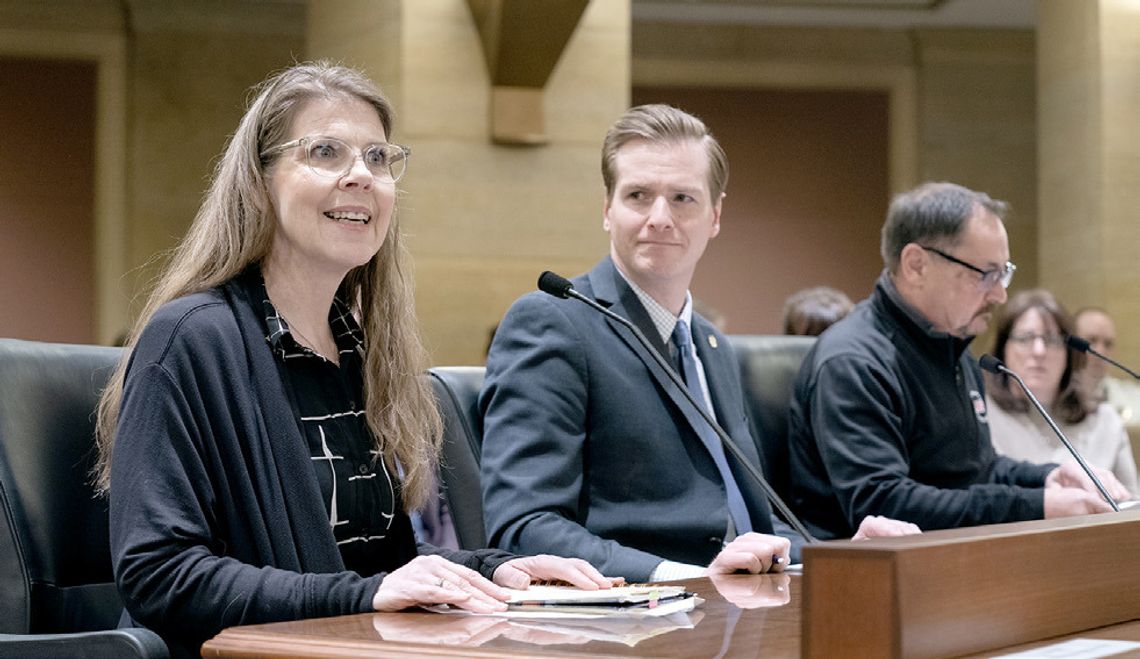On Wednesday at the state capitol, Senator Grant Hauschild (DFL, Hermantown) proposed a bill to give emergency funding to ambulance services across the state.
The bill, which is still being worked on, would provide a one-time, $120 million relief package to up to 128 licensed ambulance services across Minnesota that ran at a deficit in 2022.
The funding will be made available by the end of 2024 if the bill passes.
“I think EMS is at the forefront of the biggest challenges that our small local governments are taking on,” said Hauschild.
As a member of the Emergency Medical Services Task Force established in 2023, Hauschild has heard firsthand from community members, local officials, and EMS workers throughout the state about the need for urgent action on this crisis.
“We’ve really gone from a problem or a challenge to a crisis in Minnesota when it comes to our emergency response,” said Hauschild. “It’s the canary in the coal mine when it comes to rural healthcare.”
Hauschild said problems currently being experienced in rural Minnesota are a symptom of an underlying issue in the broader healthcare landscape in Minnesota and nationwide.
“It’s a ball that has been dropped by our federal partners,” said Hauschild. “The reimbursement rate for Medicare and Medicaid for ambulance has not kept up with the costs, and this is causing a cascading effect and a burden on many of our smallest providers.”
The lack of reimbursement from federally funded programs, such as Medicaid and Medicare, is a large reason ambulance services have been financially struggling.
2012 was the first year where ambulances could only be reimbursed by Medicare on a Medicare patient. From that point on, ambulances could not bill a Medicare patient for anything that was not covered by Medicare and have been struggling to stay afloat since.
Reimbursement rates for ambulance runs for Medicare patients are exceptionally low.
“We get $433 per run (for Medicare patients). We normally charge anybody else $1,200 a run,” said Tower mayor Dave Setterberg. “We get shorted on our revenues approximately $300,000 a year for our city.”
Tower has a population of 430 people, similar in size and demographics to many other small, rural communities in Minnesota struggling to fund EMS.
“We lost $85,000 last year, we lost $67,000 this year,” said Hoyt Lakes EMS director Melanie Olmstead.
According to Babbitt city council member Glenn Anderson, Babbitt has had to write off over $1 million for ambulance services since 2013 mainly because of this lack of reimbursement from Medicare for ambulance runs on those patients, which makes up a significant portion of their demographic.
Another critical issue rural ambulance services are facing is the increase in call volume over the last several years.
“In the 28 years that I’ve been here we’ve gone from a run volume of 1,500 calls (per year) to nearly 4,000 (calls per year) in that time frame,” said Hibbing fire chief Eric Jankila.
In many communities, the drastic increase in call volume has been accompanied by the lack of qualified EMS professionals.
Without adequate funding, many of these rural communities have struggled to attract applicants for EMS positions as the pay is better in the cities.
“EMS has been run on the backs of volunteer shift workers taking calls with little to no sleep,” said Olmstead. “It’s time EMS is taken off the back burner and focus was placed on this true crisis.”
Many rural community leaders are worried if something doesn’t change, they won’t have an ambulance service at all.
“I don’t want to see a day when somebody calls 911 and nobody comes,” said Tower area ambulance director Dena Suihkonen.
Compounding the issue of increased call volume on the Iron Range is how spread out all the residents are and the size of the counties.
With the largest counties in Minnesota geographically being in the Iron Range and northern Minnesota, this creates many difficulties for EMS.
Many ambulance services on the Iron Range currently operate in a deficit, and only survive off funding and re-allocation of local government funds, which have been drying up.
The EMS board in Minnesota determined through data collection in 2022 that the cost for the deficits facing ambulance license holders in Minnesota is $122 million.
“Hibbing residents are already subsidizing the department at $1.5 million annually so we feel it’s impossible to continue at this level or add to the department’s capacity without your support,” said Hibbing mayor Pete Hyduke. “I’m here today to plead with you to please pass and consider the funding bill.”
“Nobody really thinks about where and who’s paying for that ambulance that comes to you. You just dial 911 you expect it to be there,” continued Hyduke.
Ely Mayor Heidi Omerza testified on the struggles Ely Area Ambulance Service has faced over the last few years, and how critical this bill is to keeping EMS operational.
“Our primary service area is 1,500 square miles. That is about the size of Rhode Island,” said Omerza. “(There are) 200,000 people who like to come visit our area, so this causes quite a problem for us.”
While the Ely area has a large influx of seasonal visitors, the taxpaying base who pay for the ambulance services is only around 5,000, and the median income is only 64.4% of the state’s median income.
“Our ambulance service subsidy quadrupled over the last four years. If we were to actually put that on our levy, which we did not, it would have been a six percent increase on our levy alone,” said Omerza.
“I liken it to the fact that we are on a river, and we have a canoe, but we’ve lost our paddles and the rapids are ahead. We don’t know what to do anymore.”
The bill Hauschild proposed at the Capital is for a one-off payment of emergency funding to licensed holders for ambulance services across Minnesota as a form of relief from this deficit.
The bill has nine subdivisions of qualifications and calculating mechanisms to determine who is eligible and how much each license holder would receive.
If there are enough funds ambulance services would receive emergency funding equal to their 2022 losses.
Ely Area Ambulance Services lost $234,397.93 in 2022.
“My hope is that we are able to do something this session to help these providers in the short term,” said Hauschild.
Hauschild ended the bill proposal session by saying this is only a temporary fix that will keep EMS in Minnesota intact until they can pass mid to long-term legislation covering EMS more comprehensively.
Minnesota Senate Tax Chair Ann Rest said more details will need to be collected from ambulance services before the bill can be funded.
.jpg)











